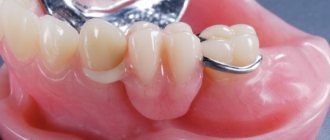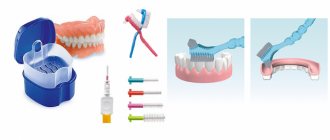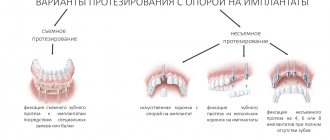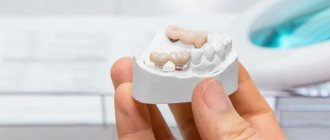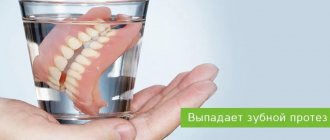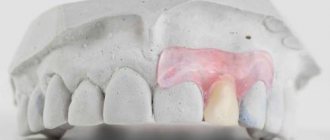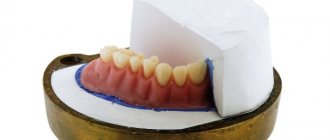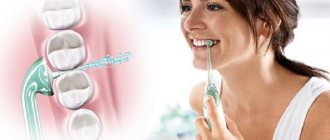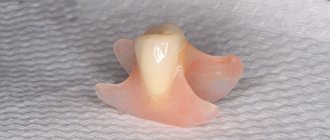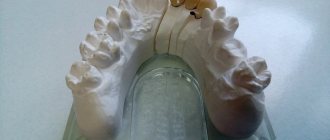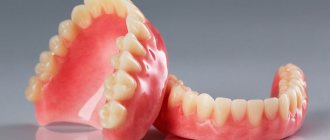2734
Removable dentures allow a person not only to restore the ability to chew food normally, but also to restore an aesthetically neat appearance.
Removable structures are distinguished by the fact that analogues of dental units are fixed on a special plate, which can be removed and installed in the oral cavity at any convenient time.
More often, such structures are worn when the maxillary or lower row is completely edentulous. With such a clinical picture, the orthopedic product imitates the jaw as a whole, repeating the natural anatomical features. A novelty in successful dental prosthetics are devices of the VIP category Deflex, which will be discussed in this article.
Features of the material
Deflex is a plastic based on linear synthetic high-molecular compounds, characterized by an increased level of elasticity and, in fact, is a semi-rigid thermoplastic.
This material also has elastic memory and is characterized by low shrinkage rates.
The main feature of orthopedic structures made from elastic material Deflex is the absence of any metal alloys.
If we compare the Deflex polyamide product with acrylic and nylon structures, it has the following advantages:
- high aesthetics;
- translucency;
- invisible fixing elements;
- relief;
- reduced thickness;
- excellent phonetics;
- absolute hypoallergenic;
- resistance to physical impact;
- functional flexibility ensuring excellent condition of supporting elements.
Remarkable! Increased rigidity primarily distinguishes the flexible material Deflex from nylons and polypropylene. It ensures correct load distribution and makes it possible to process the structure without specialized tools, bringing it to optimal shine.
The material is characterized by low water absorption and porosity , which allows the finished product to retain its original shade for a long time and not yellow like nylons and other types of soft thermoplastics.
The material is not subject to deformation during processing , and other materials for removable structures tend to melt when exposed to high temperatures. This allows it to maintain its original structure when the patient eats hot food.
Important! Deflex dentures do not react to food and drink temperatures up to 100 C°.
The increased elasticity of the material ensures reliable fixation of the clasps, without the risk of them weakening during operation.
The minimal shrinkage of the elastic polyamide Deflex allows a specialist to model any structure in accordance with the anatomical features of the patient, without the use of special gypsum material with expansion.
For reference! The thermoplastic construction Deflex belongs to the group of aesthetic prosthetics.
The material is widely used for the manufacture of the following orthopedic structures:
- partially removable products;
- fully removable;
- temporary structures;
- products in tandem with chrome.
Is there an allergy to dentures and how does it manifest itself?
Come here if you are interested in the basics of nutrition with dentures.
At this address https://zubovv.ru/protezirovanie/semnyie-p/protivopokazaniem-k-ustanovke.html we will consider contraindications to partial removable laminar dentures.
Installation of a structure in the absence of teeth
Patients often turn to dentists asking for nylon jaws to be made in cases of complete edentia. This cannot be said about the impossibility of installing such a system. But the client must understand that implementing such a design will require a lot of time, as well as money, because implants will have to be implanted to secure it.
Softness is an excellent quality for performing the basis of a system, but this only applies to partial replacement of a row. With complete edentia, discomfort from the flexible structure will begin to appear immediately when talking and chewing food.
If bridges made of plastic take on 50% of the load, then a nylon dental prosthesis redirects it to the gums. As a result, bleeding wounds form on them.
The bridge is usually attached to the teeth. In their absence, the structure is fixed with glue, which leads to patient discomfort. There is a concern that it could fall out at any time. The increased load on the jaw bones provokes their subsidence - their height decreases by one mm every year. As a result, it becomes unusable and will need to be replaced.
Therefore, dentists, in cases of complete edentia, recommend rigid structures.
Areas of use
Flexible dental orthopedic structures made of polyamide are an innovation in the field of prosthetics.
Improved material avoids problems associated with fixing removable devices on an acrylic base.
Polyamide Deflex has found wide application. Let's look at the main areas:
- replacement of partial defects (no more than 1-2 units);
- production of a complete removable type device;
- production of a sports mouthguard;
- formation of artificial gums;
- ideal for patients with aggressive stages of periodontal disease. When using them, the supporting elements do not become loose and do not require additional preparation;
- successful use in patients prone to allergic manifestations;
- the presence of contraindications, consisting mainly of acute cardiovascular diseases, epilepsy and serious health disorders of the body;
- an ideal solution for an installed structure for patients associated with traumatic professions (fire service, Ministry of Emergency Situations, police, active sports), because It is almost impossible to deform the structure or cause its failure.
Sticking effect
When making the base part, special attention is paid to the area where the gums come into contact with the cheek and lip. Thin and slightly elongated edges of the prosthesis completely cover these areas. This helps create a sort of circular valve that prevents air from leaking under the artificial gum. Advantages of this approach:
- Tight fit. Precisely manufactured adhesive dentures seem to stick to the mucous membrane.
- Aesthetics of the restored dentition. A smile looks attractive and natural.
- Comfortable use. The prosthesis sits firmly on the gums, without injuring either them or the tongue or the inner surfaces of the cheeks.
- Efficiency. You can even chew quite hard food with such teeth, without the denture moving.
Removable teeth based on an adhesive effect hold up much better than previous generation designs. In most cases, there is no need to additionally use adhesive agents, even on the lower jaw.
Contraindications
When choosing the type of prosthetics, you should take into account a number of contraindications to the installation of Deflex structures, the list of which is insignificant, but does occur:
- with very small teeth there is a risk of poor fixation of the structure;
- atrophy of the patient’s gum tissue;
- exposure of roots;
- malocclusion;
- end defects (do not always interfere with prosthetics with the presented products);
- the presence of an unhealthy element in the dentition, which will be lost in the future (there is no point in installing a polyamide prosthesis under weakened supporting teeth, since the characteristics of the material do not allow some corrective manipulations to be performed).
Modern types of clasps in removable prosthetic structures.
In this publication we will tell you what to do when your dentures become loose.
Here https://zubovv.ru/protezirovanie/semnyie-p/pravila-vyibora-opornyih.html we will figure out what criteria are used to select abutment teeth for clasp fixation.
In what cases is it used?
Polyamide prostheses are installed, as a rule, in the following cases:
- metal alloys cause an allergic reaction;
- Several elements are missing;
- edentulism;
- with restrictions on implantation, for example, with diseases of the heart, blood, immune system, and diabetes.
Deflex is installed in cases where the patient suffers from periodontitis or periodontal disease.
Polyamide prostheses are successfully used in individuals at high risk of injury, such as firefighters, athletes or police officers. It is impossible to break such a structure.
Advantages and disadvantages
Dental orthopedic structures made from soft, flexible and practical polyamide are distinguished by a number of positive characteristics, namely:
- absence of fixing clasps and metal locks (the product is equipped with alveolar-dental fastening elements that are invisible to the eye).
- high aesthetics of the prosthesis due to the translucent material, identical in color to the shade of the gums.
- lightness of the product and increased strength characteristics;
- low-impact (the design does not rub soft tissues, thanks to the precise fit and excellent fixation);
- low hygroscopicity (polyamide does not absorb moisture, so orthopedic products are highly hygienic and are indicated for patients prone to inflammatory diseases of the soft tissues of the oral cavity);
- high resistance to a humid environment , the negative effects of chemical compounds and regular cyclic stress during chewing;
- the presence of a stable dye in the material , which is not subject to destruction even when the prosthesis is worn for a long time;
- high biocompatibility with living tissues, not causing allergic reactions and intoxication;
- a quick period of adaptation and full restoration of chewing functions.
Remarkable! Deflex prostheses are recognized as the best among their analogues. They have memory for physical changes, i.e. the ability to adapt to the individual characteristics of the patient, which greatly increases reliability and comfort.
Like any other material for orthopedic structures, Deflex polyamide is not perfect. The main disadvantage of structures made from it is the impossibility of repair after a breakdown. The only way out in such a situation is a complete replacement.
Among other disadvantages, experts highlight:
- the ability to transfer chewing loads to the mucous membrane of the gum tissue and the alveolar ridge, provoking an intensive loss of the alveolar process of the jaw (however, acrylic structures also have this feature, with the exception of clasp products);
- Over time, polyamide is able to absorb dyes and odors that are difficult to remove.
The whole truth about acetal and nylon prostheses
Disadvantages of acetal and nylon prostheses:
- Due to flexibility, the stabilization of the denture deteriorates (when chewing it is more mobile, and as a result - a greater loss of bone tissue), but if the frame is made thick, then rigidity appears - but this denture becomes as bulky as a removable partial denture made of acrylic plastic .
- Polishability - does not polish properly! - due to the accumulation of plaque, dyes, change in the color of the prosthesis! Acrylic dentures and metal dentures are polished to a mirror shine!
- They are not subject to relining (if they are made entirely of acetal plastic, and if they are, then the cost of relining is comparable to the cost of a new prosthesis!) Let me explain what relining is. Over time, bone tissue decreases under the dentures and a gap appears between the gum and the denture, so in order to eliminate this, you need to clarify the prosthetic bed (that which is adjacent to the gum), that is, reline it. It is very often needed when a prosthesis was made a month or two after multiple tooth extractions. In these cases, the bone decreases faster in the first year.
- Poor fixation with short teeth and with an undefined equator.
- Plastic teeth do not chemically bond with nylon, frequent loss of plastic teeth, and the formation of dental plaque between the teeth and the nylon base.
Advantages of acetal dentures:
- Recreating aesthetics with exposed teeth. This is their very big advantage over prostheses with metal clasps. But if the crown is not high, a minus immediately appears. If the frame is pink, the tooth with the clasp looks short, and if the frame is white, it looks like something stuck to the tooth, like chewing gum.
- Good fixation - yes, but not always! Not a pronounced equator (protruding part of the tooth), low crowns, fixation is worse than that of a correctly made clasp denture.
- Do not cause allergies (except for cases of individual intolerance to nylon or acetal).
- No treatment of abutment teeth is required.
- They do not injure the enamel of the abutment tooth. (Dentures with metal clasps slightly injure the enamel of the abutment teeth)
So you will again ask the question: “why can’t I wear my old dentures?”
The most common mistake is an incorrectly defined bite! When determining the bite, the patient wanted the best and moved his jaw forward, but the doctor overlooked it. What did you get? When chewing, the denture rubs heavily in the area of the wisdom teeth! How to check? We put on the dentures, relax the jaw, take the chin with your hand and easily move the jaw up and down, resting on the chin, and close the jaw (the masticatory muscles should not be involved when closing the mouth). If the chewing teeth touch first, and the front teeth do not close, there is anterior occlusion on the face. We moved the jaw forward a little - all the teeth closed (the second confirmation of the incorrect definition of the bite).
As a result of this test, these movements set the articular heads of the lower jaw into the desired position and the teeth should close evenly! Determining occlusion is one of the main stages not only in removable prosthetics, but also in any other type of prosthetics.
Of course, you shouldn’t completely bury acetal and nylon plastic. The main thing here is the correct choice of design, the correct execution of medical and technical stages, the assistance of the “patient-doctor” - then you will get a prosthesis that will be comfortable to wear!
An example of OUR work, where an acetal prosthesis was made in combination with an acrylic base.
Installation steps
The manufacture of an orthopedic product begins with preparatory measures. The doctor examines the patient’s oral cavity, treats diseases of the teeth, gums, mucous membranes, and, if necessary, carries out extraction of destroyed elements.
Competent therapy is a very important preparatory stage and significantly reduces the risk of complications after prosthetics.
Depending on the clinical picture, the doctor may prescribe the patient hardware diagnostics and a series of tests.
The production of a prosthesis is divided into the following stages:
- Taking impressions of the patient's jaw .
This procedure is performed by a specialist using plaster, alginate or silicone material. To do this, using an impression tray, the prepared impression mixture is introduced into the oral cavity. At the end of the material hardening process, the finished impression is washed under running water and sent for further processing to a dental technician. - Laboratory works .
Manufacturing is carried out exclusively by a dental technician. Based on the impressions obtained, he casts models of the jaw and then installs them in the occluder. The primary structure is made of wax and tried on in the patient’s mouth for corrective manipulation. - Making a polyamide base .
The base is formed using special technological solutions in a polyamide heat press. A dental laboratory specialist installs artificial teeth and fixation elements on the base. In the orthopedist's office, the manufactured product is re-fitted. Next, the prosthesis is returned to the laboratory for final processing.
It is important to note that the manufacturing process of Deflex is quite complex. Technical manipulations require a certain amount of time, high experience and professionalism of the dental technician, the availability of high-quality materials and innovative equipment.
At the last stage, the finished prosthesis is installed in the patient’s oral cavity. To do this, the doctor treats the product with an antiseptic and fixes it in the oral cavity using special round-shaped polyamide hooks that tightly cover the coronal part of the adjacent unit.
The clasps are fixed in such a way that the device is securely fastened, and there is no need to prepare adjacent teeth.
For reference! Deflex removable dentures do not create additional pressure on the supporting elements, so they are recommended for installation even for those patients who have been diagnosed with increased mobility of the dentition.
Watch the video to see how the Deflex prosthesis is made.
Advantages and disadvantages
Before making a final decision, we suggest that you familiarize yourself with the main advantages of new generation orthodontic structures:
- Ensuring uniform distribution of chewing load.
- Resistant to high and low temperatures.
- Stable fixation in the oral cavity.
- Excellent adhesion to gums, retention.
- Painless and quick adaptation.
- No impact on the gums and mucous membranes of the mouth, due to which the risk of injury is reduced to zero.
- Ease of use due to low weight.
- Durability.
- Easy to maintain (no need to use additional equipment for cleaning).
- High strength, which eliminates breakage and the formation of defects even with strong impacts.
- Resistant to constant exposure to liquids, which ensures the preservation of the original shade.
- High aesthetic values.
- No effect on the taste of food.
Such an impressive list of advantages is typical only for polyamide prostheses produced under the Deflex brand. Analogue products made of nylon or acrylic have only individual advantages.
The designs in question have few disadvantages:
- High price. Not every patient has enough funds to install a polyamide prosthesis, so when choosing orthodontic treatment, it is important to take into account all the features of the clinical picture.
- Little application experience. Since the material was recently invented, experience with its use is limited. Not every clinic offers patients the manufacture of polyamide products.
Impossibility of restoration. Broken polyamide structures cannot be repaired. The only solution will be re-prosthetics.
Price issue
Flexible prostheses are much more expensive than their counterparts made of plastic and acrylic materials. Let's consider the average cost of various types of structures made from the presented material in Moscow clinics of an affordable price category using the table as an example.
| View | Price in rubles |
| Full removable | 45 000 |
| Partial removable | 38 000 |
| Micro-prosthesis for 1-2 teeth | From 10 000 |
The final cost will depend on the following nuances:
- the treatment used at the preparatory stage;
- installation cost;
- doctor's qualifications and experience;
- prestige of the clinic;
- complexity of the case;
- individual characteristics of the patient.
Advantages of thermoplastic dentures
Rice. 1. Valplast nylon prosthesis.
1. Aesthetics
Instead of the metal clasps of acrylic dentures, nylon ones have these elements made of white (tooth-colored) or red (gum-colored) plastic.
2. Durability
The impact strength of flexible prostheses is such that it is almost impossible to break them if accidentally dropped on the floor.
3. Adaptation
It is easier to get used to a nylon prosthesis.
Reviews
The presented new type of dental prosthetics using Deflex orthopedic structures has predominantly positive qualities and is practically devoid of negative characteristics.
This type is made of thermoplastic material, which has high aesthetic qualities - the product cannot be seen in the oral cavity.
If you have something to share with our readers about the prostheses discussed in the article, we welcome your feedback in the comments below.
If you find an error, please select a piece of text and press Ctrl+Enter.
Tags prosthetics removable dentures
Did you like the article? stay tuned
No comments yet
Possible breakdowns
Damage to the integrity of Vertex products is quite rare, however, dentists identify the following situations in which product repair may be required:
- chipping or loss of an artificial tooth is eliminated in a dental laboratory by installing a new element of the row;
- if the product adheres poorly to soft tissues, adjustment of the base may be required;
- Elimination of a broken lock is carried out by replacing it with a new one;
- When cracks or breaks in the base appear, it is repaired or a new structure is made.
Dentists pay attention that repairs should only be carried out by specialized specialists. Independent actions can cause even more damage to the structure.
Competent care
Despite the high level of hygiene of nylon dentures, they require regular care, just like “living” teeth. After each meal, the denture must be rinsed with running water.
If the patient does not have the opportunity to do this immediately after eating, he should first rinse the mouth thoroughly with water , and then, when possible, remove the denture and rinse it.
To avoid damage when washing the prosthesis, you should perform the procedure over a sink filled with water or a towel folded in several layers.
This is especially true for nylon dentures, which additionally have acrylic elements installed - they can be damaged if they fall on a sink.
In the morning and evening, the denture should be cleaned in the same way as regular teeth, using a specially formulated toothpaste (without abrasive elements) and a soft-bristled brush. Specific tools for care are selected individually, together with the dentist.
At night, the structure is placed in a container with a special cleaning solution, or in an ultrasonic bath. This is necessary for better cleaning of the prosthesis and high-quality service throughout its entire service life.
At least once every six months, the denture should be submitted to a dental laboratory for professional cleaning. There, highly specialized cleaning of microdamages that cannot be eliminated on your own, polishing of the surface and elimination of microdamages takes place.
During these routine cleanings, the patient's gums are also examined and, if necessary, the denture is adjusted. Because Nylon is a plastic material; it can be deformed during wear, so such a procedure is necessary.
